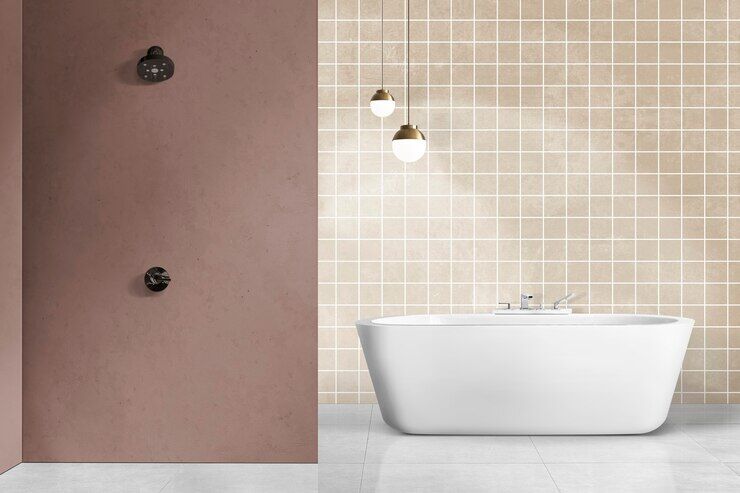
Bathroom Wall Materials

Transforming your bathroom starts with the essentials of both functionality and design. At Clearview Renovations, selecting the perfect wall materials combines aesthetics, durability, and practicality to elevate your bathroom experience. This guide explores top options, helping you make informed choices for your next renovation project.
Key Takeaways
- Tiles are ideal for water-exposed areas due to their durability.
- Paint provides an affordable and versatile option but requires moisture-resistant finishes.
- Wall panels offer seamless, modern alternatives with minimal maintenance.
- Focus on durability, style, and budget when selecting wall materials.
Why Selecting the Right Materials for Your Bathroom Walls Matters
Bathroom walls are constantly exposed to moisture, temperature changes, and everyday wear. Selecting the right materials ensures longevity while creating a stylish, low-maintenance space. Choosing surfaces that are easy to clean also helps maintain overall bathroom cleanliness. From tiles to paint, understanding the options helps strike a balance between form, function, and keeping the space pristine..
Top Bathroom Wall Material Options
- Ceramic and Porcelain Tiles: Tiles remain a timeless choice for bathroom walls due to their durability and water resistance.
- Features: Ceramic and porcelain tiles are incredibly easy to clean and maintain, making them ideal for areas with high moisture exposure. They are highly resistant to water, stains, and mould, ensuring long-term durability without compromising on hygiene.
- Design Flexibility: Tiles are available in an extensive range of colours, patterns, sizes, and textures, allowing for endless design possibilities. Tiles can be customised to complement any design style, whether it’s classic, contemporary, or eclectic.
- Maintenance: Regular cleaning with mild detergent and sealing grout lines periodically will keep tiles looking fresh and polished for years, ensuring both functionality and aesthetic appeal.
- Paint: Paint is an affordable and versatile choice for bathroom walls, especially in areas not directly exposed to water.
- Moisture-Resistant Paints: Specialised moisture-resistant paints, such as high-quality acrylic or semi-gloss finishes, are specifically designed for humid environments. These paints prevent peeling, resist mould, and are easier to clean compared to standard wall paints.
- Colour Options: Paint offers an array of colour choices, from light pastel shades that make smaller bathrooms feel airy and open, to deep, bold hues for creating a dramatic, sophisticated effect.
- Application Tips: Proper application is crucial for longevity. Use a quality primer to ensure adhesion and finish with mildew-resistant paint to protect the walls in damp areas. Adequate ventilation during and after application is essential for durability.
- Bathroom Wall Panels: Wall panels offer a sleek, modern alternative that provides seamless, stylish solutions with minimal upkeep.
- Materials: Common materials include PVC, acrylic, and laminate. Each offers a durable, waterproof surface designed to withstand the challenges of a humid environment. These materials are lightweight, easy to handle, and available in various finishes.
- Benefits: Wall panels are quick to install and require no grout lines, which reduces the risk of mould and makes cleaning significantly easier. They are also impact-resistant and highly durable, making them a practical option for busy households.
- Design Variety: Panels are available in a range of designs, including those that mimic the look of natural materials like marble, wood, or stone. This versatility makes it possible to achieve a luxurious aesthetic without the associated cost or maintenance.
Tips for Selecting Bathroom Wall Materials
-
Focus on Durability
Bathrooms are exposed to high levels of moisture, temperature fluctuations, and daily wear, making durability a critical factor when choosing wall materials. Opt for options like ceramic tiles or waterproof wall panels, which are specifically designed to withstand wet environments. These materials resist water seepage, prevent mould growth, and maintain their appearance over time with minimal maintenance.
-
Prioritise Style
The wall materials should align with the overall aesthetic of the bathroom to create a cohesive bathroom design. Sleek and polished tiles in neutral tones or bold patterns work beautifully in modern or contemporary bathrooms, adding sophistication and charm. For a more traditional or rustic style, wood-look panels or textured finishes can bring warmth and character, creating a cosy yet elegant bathroom design.
-
Consider Your Budget
Finding the right balance between cost and quality is essential when selecting wall materials. Paint is one of the most budget-friendly options, ideal for areas not directly exposed to water, but it may require frequent touch-ups over time. Alternatively, investing in high-quality tiles or durable wall panels can save money in the long run, thanks to their longevity and low-maintenance properties.
-
Choose the Right Finish
The overall atmosphere of the bathroom is greatly influenced by the wall material’s finish. Glossy finishes are an excellent choice for smaller bathrooms as they reflect light and create a sense of spaciousness. On the other hand, matte surfaces offer a softer, more refined appearance that enhances a calm and cosy atmosphere, making them perfect for larger bathrooms or those with a more traditional design.
Tips on Selecting Tiles, Paint, and Panelling
- Tiles: Opt for larger tiles in smaller bathrooms to create an illusion of spaciousness, as fewer grout lines provide a cleaner and more open appearance. Additionally, consider grout colour carefully subtle and neutral hues can seamlessly blend with the tiles, enhancing the overall look without drawing attention to the joints.
- Paint: Avoid using flat or matte paints in areas exposed to direct water, as these finishes lack the necessary moisture resistance. Instead, choose high-quality mildew-resistant paints, such as semi-gloss or satin finishes, to protect the walls while adding a subtle sheen that complements bathroom aesthetics.
- Panelling: Match the texture and material of wall panels to the overall style of the bathroom. For a sleek and modern look, smooth and glossy panels are ideal, while woodgrain or textured finishes can add warmth and character to traditional or rustic-style bathrooms. Panel materials like PVC and acrylic are not only durable but also easy to maintain, making them a practical choice for busy households.
Conclusion
Bathroom walls play a pivotal role in defining both the functionality and style of the space. Whether you prefer classic tiles, modern panels, or cost-effective paint, your choice should reflect your lifestyle, design preferences, and long-term maintenance needs. For tailored bathroom renovations, contact us today. Let us help you create a space that balances beauty and practicality with expert craftsmanship.
FAQs
- Which material is most suitable for shower walls?
Ceramic and porcelain tiles are excellent for showers due to their water resistance and durability.
- Can regular paint be used in the bathroom?
No, regular paint is not suitable for wet environments. Apply moisture-resistant paint to safeguard surfaces from peeling and the growth of mould.
- Are wall panels expensive?
Wall panels can be cost-effective compared to tiles, depending on the material. PVC and acrylic panels are budget-friendly options.
- How should tiled bathroom walls be maintained?
Regularly clean with a mild detergent and scrub grout lines to prevent discolouration or mould growth.
- Can wood panelling be used in bathrooms?
Wood panelling requires sealing to protect against moisture, making it a less common choice for high-moisture areas.
- How can a small bathroom appear larger?
Opt for light-coloured tiles or paint, glossy finishes, and vertical wall panels to create an illusion of space.
- Category :
- Type :
